Wood carving is an ancient art form that has been practiced for centuries across different cultures. It involves shaping wood by removing parts of it, using a variety of tools. The result is a functional or decorative piece that reflects the skill and creativity of the carver. From intricate sculptures to practical utensils, wood carving has a wide range of applications.
Wood carving can be broadly classified into three categories: chip carving, relief carving, and sculptural carving. Chip carving involves removing small chips from the wood to create patterns or designs. Relief carving is a process where the carved figures seem to rise out of the material, while sculptural carving involves creating three-dimensional figures from the wood.
Regardless of the type of carving, one thing remains constant – the need for a good carving knife. The knife is the carver’s primary tool, and its quality can significantly impact the outcome of the carving process.
Our Top Wood Carving Knife Picks
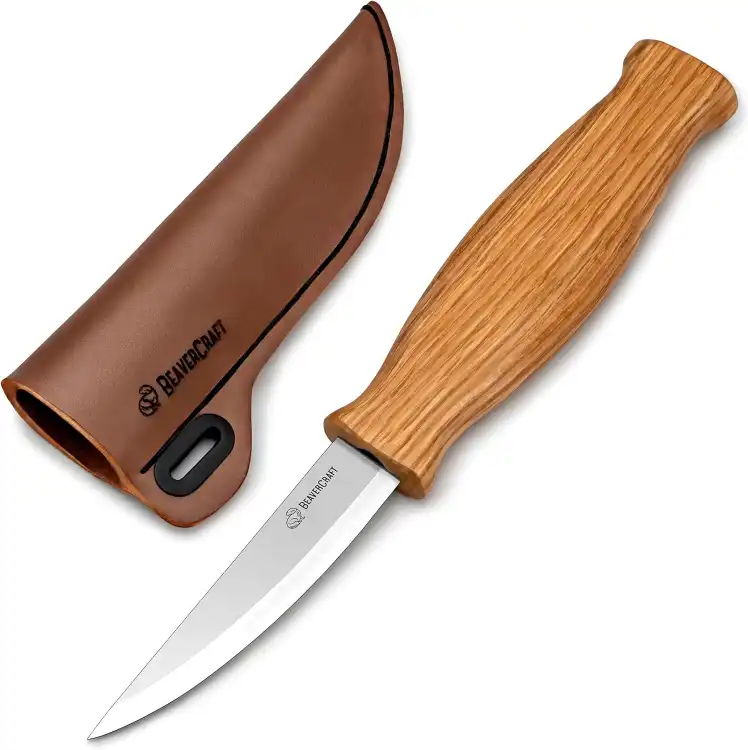
BeaverCraft Wood Carving Sloyd Knife
Check on AmazonKey Specs
- Blade Material: 1066 High-Carbon Steel
- Handle Material: Oak wood with linseed oil finish
- Blade Length: 8 centimeters
- Included: Leather cowhide sheath
- Uses: Whittling, shaping, green woodworking, roughing
The C4s Sloyd Knife from BeaverCraft has become one of my go-to blades for both rough shaping and tight-detail work. Its 1066 high-carbon steel edge keeps sharp even after hours of carving. I love the handle—oiled oak that fits perfectly in hand, offering control without fatigue. The curve and length of the blade are ideal for versatile tasks. Plus, the included cowhide sheath? A must-have for protecting the edge in the field or workshop.
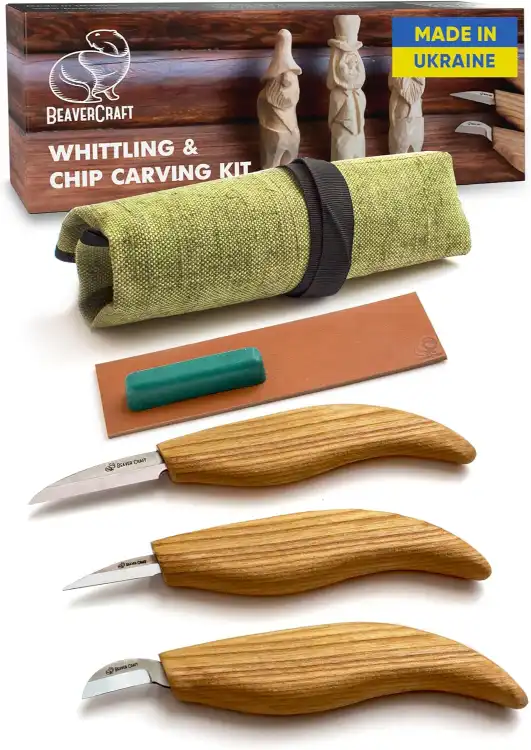
BeaverCraft Wood Carving Kit
Check on AmazonKey Specs:
- Material: High-carbon steel
- Included: Detail knife, chip carving knife, roughing knife, leather strop, polishing compound, canvas tool roll
- Blade Length: 1 inch
- Handle Material: Wood, ergonomic design
- Target Audience: Beginners and kids (ages 8-12)
The BeaverCraft S15 Wood Carving Kit is a comprehensive set that provides everything needed to start carving, including essential knives and tools. What I love about this kit is the ergonomic design of the handles, making carving comfortable even during extended sessions. The pre-sharpened blades are a real bonus, allowing for immediate use. The inclusion of a leather strop and polishing compound is great for maintaining sharpness. This set is perfect for both beginners and kids, offering high-quality tools that inspire creativity.
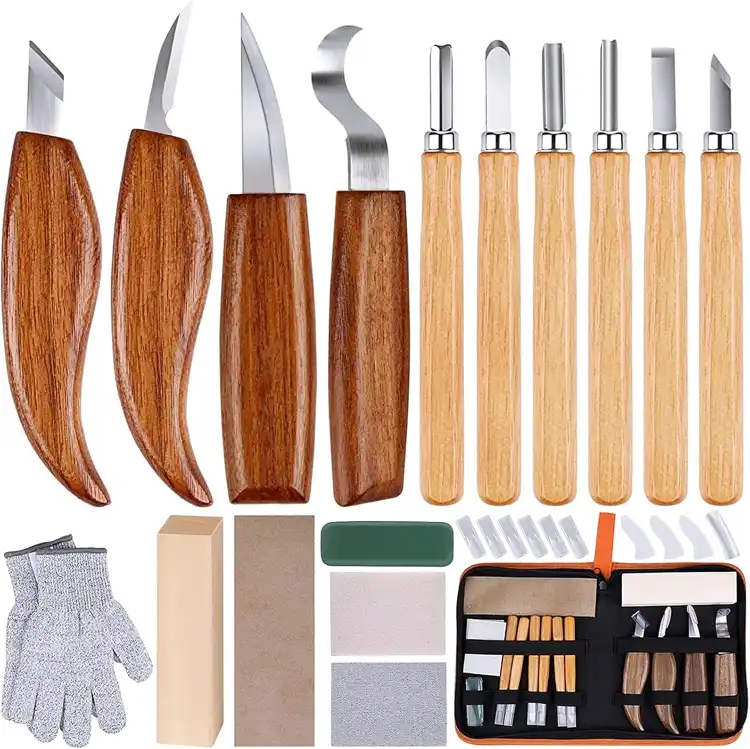
26-in-1 Wood Carving Kit
Check on AmazonKey Specs:
- Material: Stainless steel blades, black walnut wood handles
- Includes: 26 tools, including 6 carbon steel chisels, 9 blade protectors, gloves, polishing compound, and wood blank
- Blade Length: 5 centimeters
- Item Weight: 310 grams
- Use: Ideal for carving spoons, cups, bowls, and detailed woodwork
The Olerqzer 26-in-1 Wood Carving Kit is a fantastic all-in-one solution for both beginners and experienced carvers. The set includes a variety of essential knives, such as the detail knife, whittling knife, and hook knife, perfect for shaping, carving, and adding intricate details to wood projects. The ergonomic black walnut handles provide comfort, and the inclusion of cut-resistant gloves ensures safety. The wood blank is a nice touch for practicing, and the leather strop with polishing compound helps keep your tools in top condition.
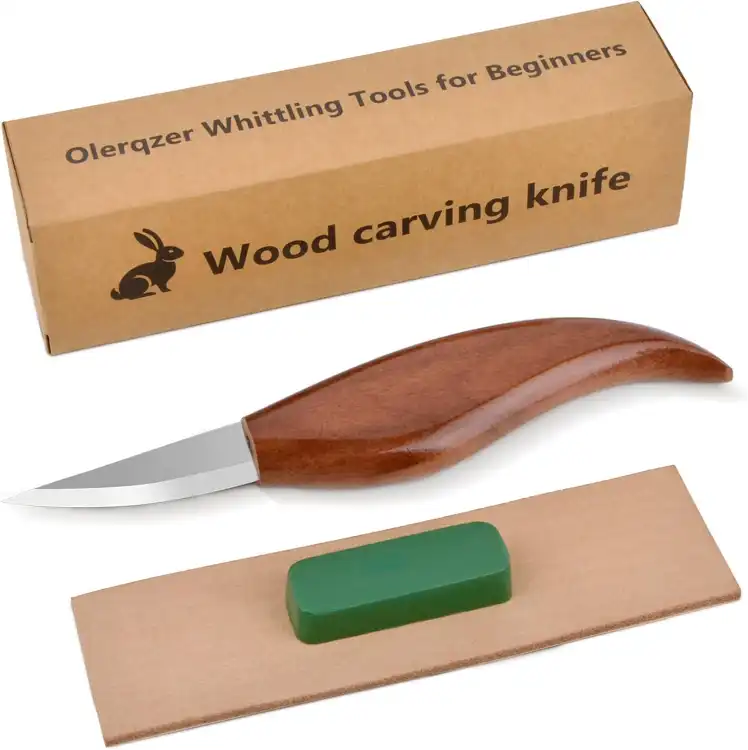
Wood Carving Knife With Leather Strop and Polishing Compound
Check on AmazonKey Specs:
- Blade Material: High-carbon steel
- Handle Material: Black walnut wood
- Includes: Leather strop and polishing compound
- Recommended Uses: Wood carving, whittling, DIY projects
- Ergonomics: Comfortable, fatigue-reducing handle design
The Olerqzer Sloyd Carving Knife is a fantastic choice for anyone looking to start or enhance their wood carving journey. Crafted from high-carbon steel, the blade is razor-sharp and durable, allowing for precise cuts through hardwoods like oak and walnut. The ergonomic black walnut handle ensures comfort during extended carving sessions. The inclusion of a leather strop and polishing compound ensures your knife stays sharp with minimal effort, making this tool perfect for beginners and experienced carvers alike.
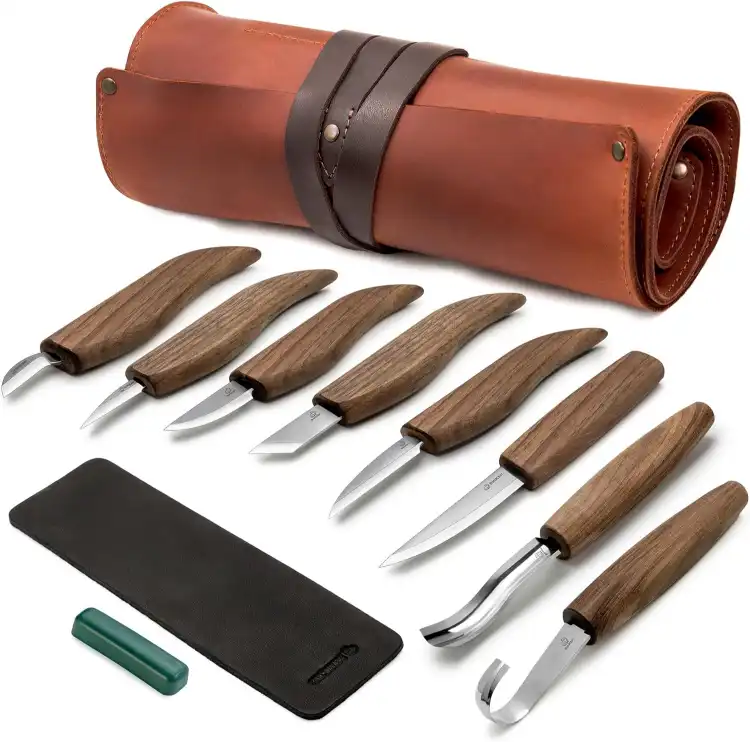
BeaverCraft Deluxe Wood Carving Kit
Check on AmazonKey Specs:
- Blade Material: High-carbon steel
- Handle Material: Chocolate walnut wood
- Includes: 8 whittling tools and stropping kit
- Storage: Genuine leather pouch
- Dimensions: 10.63″L x 7.56″W
The BeaverCraft Deluxe Wood Carving Kit S18X stands out with its top-tier craftsmanship and attention to detail. The high-carbon steel blades deliver exceptional sharpness and durability, perfect for intricate wood carving projects. The chocolate walnut handles not only offer a stylish look but also provide a comfortable, ergonomic grip for extended use. The genuine leather pouch keeps everything neatly organized and protected. This comprehensive kit, including 8 tools and a stropping kit, is a must-have for anyone serious about wood carving.
Importance of a Good Wood Carving Knife
A good wood carving knife is essential for any wood carving project. It is the primary tool used to shape and detail the wood, and its quality can significantly impact the final product. A sharp, durable knife allows for precise cuts and reduces the risk of mistakes, which can be difficult to correct.
Furthermore, a good wood carving knife can enhance the carver’s efficiency. It can make the carving process smoother and faster, reducing the amount of time and effort required. This is particularly important for professional carvers, for whom time is often a critical factor.
Lastly, a good wood carving knife can also contribute to the carver’s safety. A dull or poor-quality knife can slip or break during use, potentially causing injury. Therefore, investing in a good wood carving knife is not only a matter of quality and efficiency but also of safety.
Understanding Wood Carving Knives
Definition and Purpose of a Wood Carving Knife
A wood carving knife, also known as a whittling knife, is a tool specifically designed for carving wood. It typically has a thin, pointed blade that allows for precise cuts and detailing. The purpose of a wood carving knife is to remove parts of the wood to create a desired shape or design.
Wood carving knives are used in a variety of woodworking tasks, from creating intricate sculptures to crafting practical items like utensils and furniture. They are also used in traditional crafts like spoon carving and chip carving. The versatility of these knives makes them an essential tool for any woodworker, whether amateur or professional.
It’s important to note that not all knives are suitable for wood carving. The blade needs to be sharp enough to cut through the wood without splintering it, and the handle needs to be comfortable to hold for extended periods. Therefore, when choosing a wood carving knife, it’s crucial to consider these factors.
Different Types of Wood Carving Knives
There are several types of wood carving knives, each designed for specific tasks. The most common types include the chip carving knife, the detail knife, the straight gouge, the V-tool, and the spoon knife.
The chip carving knife is used for making precise, triangular cuts into the wood. It has a short, pointed blade that allows for detailed work. The detail knife, as the name suggests, is used for detailing and finishing work. It has a very sharp, thin blade that can make fine cuts.
The straight gouge is a type of chisel with a curved cutting edge, used for making deep, rounded cuts. The V-tool, also a type of chisel, has a V-shaped cutting edge and is used for making sharp, angular cuts. The spoon knife, with its curved blade, is specifically designed for carving spoons and bowls.
Each of these knives has its own strengths and uses, and many wood carvers have a collection of different types to handle a variety of tasks. However, for beginners, a good-quality chip carving knife or detail knife is often sufficient to start with.
Factors to Consider When Buying a Wood Carving Knife
Sharpness
One of the most important factors to consider when buying a wood carving knife is its sharpness. A sharp knife allows for precise, clean cuts, making the carving process smoother and more efficient. It also reduces the risk of the knife slipping or the wood splintering, both of which can lead to mistakes or injuries.
However, it’s important to note that not all sharp knives are suitable for wood carving. The blade needs to be thin enough to make detailed cuts, but also strong enough to withstand the pressure of carving. Therefore, when assessing the sharpness of a knife, consider both the thinness of the blade and its strength.
Additionally, keep in mind that even the sharpest knife will dull with use. Therefore, it’s important to also consider how easy the knife is to sharpen, and how well it holds its edge after sharpening.
Comfort
Comfort is another crucial factor to consider when buying a wood carving knife. Carving can be a time-consuming process, and using a knife that is uncomfortable to hold can lead to hand fatigue or even injury.
The handle of the knife should fit comfortably in your hand, with a shape that allows for a secure grip. It should also be made of a material that is pleasant to touch and doesn’t cause irritation or discomfort with prolonged use.
Additionally, the weight of the knife can also affect its comfort. A knife that is too heavy can be difficult to control and can cause hand fatigue, while a knife that is too light may not provide enough force for effective carving. Therefore, it’s important to find a knife that has a good balance of weight and control.
Durability
Durability is a key factor to consider when buying a wood carving knife. A durable knife will withstand the rigors of carving without breaking or wearing out, providing reliable performance over time.
The durability of a knife largely depends on the quality of its materials. The blade should be made of a strong, hard material that can withstand the pressure of carving. High-carbon steel is a popular choice for wood carving knives, as it is both strong and sharp.
The handle should also be durable, as it needs to withstand the force exerted during carving. It should be made of a sturdy material like hardwood or plastic, and it should be securely attached to the blade.
Finally, consider the overall construction of the knife. It should be well-made, with no loose or wobbly parts. A well-constructed knife will not only last longer, but also provide better performance and safety.
Price
Price is always a factor to consider when buying any product, and wood carving knives are no exception. However, it’s important to remember that price is not always indicative of quality. A high-priced knife is not necessarily better than a lower-priced one, and vice versa.
When considering the price of a wood carving knife, consider what you’re getting for your money. Does the knife have a high-quality blade and handle? Does it come with any extras, like a sheath or a sharpening stone? Is it from a reputable brand with good customer reviews?
Also, consider your own needs and budget. If you’re a beginner or a casual carver, you may not need a high-end knife with all the bells and whistles. A simple, well-made knife may be more than sufficient. However, if you’re a professional carver or a serious hobbyist, it may be worth investing in a higher-quality knife that will provide better performance and durability.
Brand Reputation
Finally, consider the reputation of the brand when buying a wood carving knife. A reputable brand is more likely to produce high-quality knives that are reliable and durable. They are also more likely to provide good customer service, including warranty and repair services.
There are many ways to assess the reputation of a brand. You can read customer reviews online, ask for recommendations from other carvers, or check the brand’s ratings on consumer websites. You can also look at the brand’s history and experience in the industry. A brand that has been around for a long time and specializes in wood carving tools is likely to produce high-quality knives.
However, don’t let brand reputation be your only guide. Even lesser-known brands can produce excellent knives, and even reputable brands can have occasional misses. Therefore, always consider the specific features and qualities of the knife, in addition to the reputation of the brand.
Detailed Analysis of Wood Carving Knife Features
Blade Material and Sharpness
The blade is the most important part of a wood carving knife, and its material and sharpness can significantly impact the knife’s performance. The blade should be made of a strong, hard material that can withstand the pressure of carving. High-carbon steel is a popular choice, as it is both strong and sharp.
The sharpness of the blade is also crucial. A sharp blade allows for precise, clean cuts, making the carving process smoother and more efficient. It also reduces the risk of the knife slipping or the wood splintering, which can lead to mistakes or injuries.
However, even the sharpest blade will dull with use. Therefore, it’s important to consider how easy the blade is to sharpen, and how well it holds its edge after sharpening. Some blades may require special tools or techniques to sharpen, while others can be sharpened with a simple whetstone.
Handle Design and Comfort
The handle of a wood carving knife is also important, as it affects the comfort and control of the knife. The handle should fit comfortably in your hand, with a shape that allows for a secure grip. It should also be made of a material that is pleasant to touch and doesn’t cause irritation or discomfort with prolonged use.
The design of the handle can also affect the control of the knife. A well-designed handle will allow for precise, controlled cuts, making the carving process easier and more efficient. It should also be balanced with the blade, to prevent the knife from being too heavy or too light.
Finally, consider the durability of the handle. It should be made of a sturdy material that can withstand the force exerted during carving, and it should be securely attached to the blade. A loose or wobbly handle can be dangerous, as it can cause the knife to slip or break during use.
Knife Size and Weight
The size and weight of a wood carving knife can also affect its performance and comfort. The knife should be of a size that fits comfortably in your hand, allowing for a secure grip and precise control. A knife that is too large or too small can be difficult to control, leading to mistakes or injuries.
The weight of the knife is also important. A knife that is too heavy can cause hand fatigue and can be difficult to control, while a knife that is too light may not provide enough force for effective carving. Therefore, it’s important to find a knife that has a good balance of weight and control.
Keep in mind that the ideal size and weight of a knife can vary depending on the user and the task. For detailed, intricate work, a smaller, lighter knife may be preferable. For larger, rougher cuts, a larger, heavier knife may be more effective. Therefore, it’s important to consider your own needs and preferences when choosing a knife.
Safety Features
Safety is a crucial consideration when using a wood carving knife. A good knife should have features that enhance safety, such as a secure grip, a sturdy construction, and a sheath for storage.
The grip of the knife should be secure and comfortable, to prevent the knife from slipping during use. The handle should be made of a non-slip material, and it should fit comfortably in your hand. Some knives also have finger guards, which can provide additional protection.
The construction of the knife should also be sturdy and reliable. A well-made knife is less likely to break or fail during use, reducing the risk of injury. The blade should be securely attached to the handle, and there should be no loose or wobbly parts.
Finally, a good knife should come with a sheath for safe storage. The sheath should fit the knife snugly, to prevent the blade from being exposed. It should also be made of a durable material, to protect the knife from damage.
Top Wood Carving Knife Brands
Overview of Top Brands
There are many brands that produce wood carving knives, but some stand out for their quality, reliability, and reputation. Here are a few of the top brands:
Morakniv: This Swedish brand is known for its high-quality knives, made with top-grade Swedish steel. Their wood carving knives are popular for their sharpness, durability, and comfortable handles.
Flexcut: This American brand specializes in wood carving tools, and their knives are praised for their sharpness, comfort, and versatility. They offer a wide range of knives, from basic whittling knives to specialized carving tools.
BeaverCraft: This Ukrainian brand offers a range of affordable, high-quality wood carving knives. Their knives are made with high-carbon steel and hardwood handles, and they are popular among beginners and professionals alike.
These are just a few examples, and there are many other excellent brands out there. When choosing a brand, consider their reputation, the quality of their products, and the needs and preferences of the user.
Comparison of Their Key Features
While all of these brands produce high-quality wood carving knives, they each have their own strengths and features. Here is a comparison of their key features:
Morakniv: Morakniv knives are known for their high-quality Swedish steel blades, which are sharp, durable, and easy to sharpen. They also have comfortable, ergonomic handles, and they come with sturdy plastic sheaths for safe storage. However, they tend to be more expensive than other brands.
Flexcut: Flexcut knives are praised for their sharpness and versatility. They have flexible blades that allow for a wide range of cuts, and their handles are designed for comfort and control. They also offer a wide range of knives, making it easy to find the right tool for any task. However, their knives can be difficult to sharpen, due to their unique blade shape.
BeaverCraft: BeaverCraft knives are affordable and high-quality, making them a great choice for beginners. They have sharp, high-carbon steel blades and comfortable hardwood handles. They also come with leather sheaths for safe storage. However, their range of knives is somewhat limited compared to other brands.
These are just a few examples, and the best brand for you will depend on your specific needs and preferences. Always consider the quality of the knife, the reputation of the brand, and the needs of the user when choosing a wood carving knife.
How to Maintain Your Wood Carving Knife
Proper Cleaning and Storage
Proper cleaning and storage are crucial for maintaining your wood carving knife. After each use, clean the knife with a soft cloth to remove any wood particles or residue. If the knife is particularly dirty, you can use a mild soap and warm water, but be sure to dry it thoroughly afterwards to prevent rusting.
Store the knife in a dry, safe place, away from moisture and extreme temperatures. If the knife comes with a sheath, use it to protect the blade from damage. If not, consider investing in a knife block or magnetic strip for safe storage.
Never store the knife in a drawer or box with other tools or objects, as this can lead to scratches or damage. Also, keep the knife out of reach of children and pets, for their safety and the safety of the knife.
Regular Sharpening
Regular sharpening is also important for maintaining your wood carving knife. A sharp knife is not only more effective, but also safer to use, as it requires less force and is less likely to slip.
Sharpen your knife regularly, depending on how often you use it. A good rule of thumb is to sharpen it every few hours of carving, or whenever you notice the knife becoming dull. Use a whetstone or a specialized knife sharpener, and follow the manufacturer’s instructions for best results.
Remember to sharpen the entire length of the blade, from the base to the tip. Also, be sure to maintain the original angle of the blade, as changing the angle can affect the performance of the knife.
Tips to Prolong Knife Lifespan
With proper care and maintenance, a good wood carving knife can last for many years. Here are a few tips to prolong the lifespan of your knife:
Use the knife for its intended purpose: Wood carving knives are designed for carving wood, and using them for other tasks can damage the blade or the handle. Avoid using your knife on hard materials like metal or stone, and never use it as a pry bar or a screwdriver.
Handle the knife with care: While wood carving knives are sturdy, they are not indestructible. Avoid dropping the knife or hitting it against hard surfaces, as this can damage the blade or the handle. Also, avoid applying excessive force when carving, as this can lead to the blade breaking or bending.
Protect the knife from moisture: Moisture can cause the blade to rust and the handle to warp or crack. Always dry the knife thoroughly after cleaning, and store it in a dry, well-ventilated place. If you live in a humid climate, consider using a dehumidifier or silica gel packets to keep your storage area dry.
With these tips, you can keep your wood carving knife in top condition, ensuring that it provides reliable performance for many years to come.
Safety Tips When Using a Wood Carving Knife
Proper Handling and Usage
Proper handling and usage are crucial for safety when using a wood carving knife. Always hold the knife with a secure grip, and keep your fingers away from the blade. Use controlled, deliberate movements, and avoid rushing or forcing the knife through the wood.
Always carve away from your body, and keep your other hand clear of the blade. If you need to hold the wood while carving, hold it on the opposite side of where you’re carving, to avoid accidental cuts.
Also, remember to take breaks regularly, especially if you’re carving for long periods. This can help prevent hand fatigue, which can lead to loss of control or mistakes.
Protective Gear
Using protective gear can also enhance safety when using a wood carving knife. Consider wearing a carving glove or thumb guard to protect your hand from accidental cuts. If you’re carving small or intricate pieces, consider using a carving vise or clamp to hold the wood, to keep your fingers away from the blade.
Also, consider your work environment. Work in a well-lit, well-ventilated area, and keep your work area clean and free of clutter. This can help prevent accidents and make the carving process more comfortable and enjoyable.
First Aid Measures for Potential Injuries
Despite your best efforts, accidents can still happen when using a wood carving knife. Therefore, it’s important to be prepared for potential injuries.
If you cut yourself, clean the wound immediately with warm water and soap, and apply a clean bandage. If the cut is deep or doesn’t stop bleeding, seek medical attention immediately.
Also, consider taking a first aid course, or at least familiarizing yourself with basic first aid procedures. This can help you respond effectively to any injuries, reducing the risk of complications or infections.
Finally, always keep a first aid kit in your work area, and make sure it’s stocked with bandages, antiseptic wipes, and other basic supplies. This can help you respond quickly to any injuries, reducing the risk of complications or infections.
Conclusion
Recap of the Importance of Choosing the Right Wood Carving Knife
Choosing the right wood carving knife is crucial for any wood carving project. A good knife can enhance the quality of your work, make the carving process more efficient, and reduce the risk of mistakes or injuries.
When choosing a wood carving knife, consider factors like sharpness, comfort, durability, price, and brand
